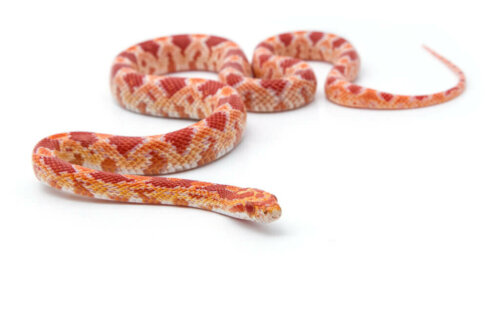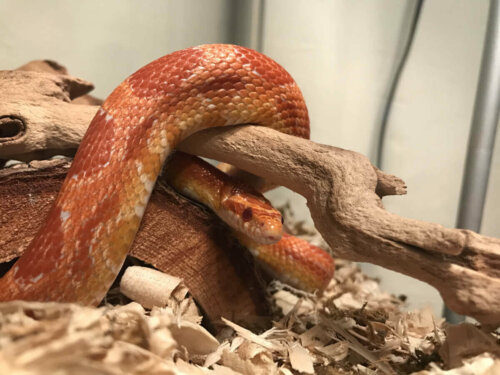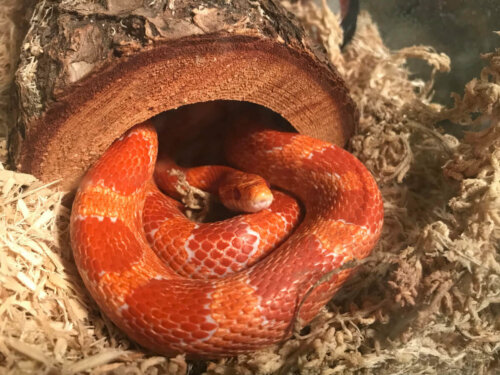How to Properly Care for a Pet Corn Snake

Have you ever wanted to get an exotic pet but are concerned about your lack of experience? Do you have a passion for snakes? Did you answer “yes” to both questions? Read on then, the corn snake might just be the ideal pet for you.
This animal is a colubrid raised in most reptile farms and it’s widely popular in the world of terrariumphilia due to its small size, nice demeanor, and low-maintenance. This guide will be quite useful to you if you’re planning on adopting one of these beautiful animals.
Things to consider before adopting a corn snake
The corn snake (Pantherophis guttatus) is a colubrid endemic to the Southeastern USA and inhabits areas from New Jersey to Florida. It’s typical of open forests and low crops such as corn, hence its nickname.
Firstly, note that this species was previously included in the genus Elaphe but genetic studies elucidated that the reptile in fact belongs to the genus Pantherophis.
Even so, this species is still known in the exotic animal market by the scientific name of Elaphe guttata. Let’s emphasize Elaphe and Pantherophis are the same species. This is because taxonomic variation between genera often confuses potential guardians.
You must also know that this animal isn’t a part of the CITES convention — a treaty for the protection of endangered species. Thus, people don’t need special permits to adopt one. All specimens currently for sale were bred in captivity so keeping them as pets is legal.

How to care for a pet corn snake
Let’s begin with some basic information about this snake, it can measure between 24 and 70 inches long. It requires more space than many other exotic reptiles even though it won’t get as large as a boa.
Terrarium
One of these specimens requires a 22-gallon terrarium that’s about 35 inches long by 16 inches wide. In addition, the facility must also be about 12-16 inches high. This is because it must contain branches and stones for the snake to move around. You may not be aware of it but environmental enrichment is essential for exotic animals.
The good news is the terrarium can be made of any material. You can either have a wooden enclosure with a mesh roof for aeration or a specialized glass one. The snake won’t really care about the material in their home but they’ll certainly look striking in a glass facility.
As you set up the terrarium to house your new pet, you must keep in mind that these snakes need to have a private den. Thus, you must provide them with a hiding place where they can have some “me-time.”
These snakes are expert escapists so you must close and secure the enclosure well every time you access it.
Environmental conditions
As with most reptiles, the temperature of the terrarium is the key to the survival and well-being of corn snakes. Let’s see what their environmental requirements are:
- The temperature should range from 75-82°F on the cool side and 80-85°F on the warm side. Provide an 88-92°F basking area on the warm side of the terrarium. Place a thermal blanket to achieve this temperature gradient – always below and outside the terrarium. It must cover about 1/4 of its surface area.
- The relative humidity should be between 40-60 %. Given this is a low value, placing a container with water in the terrarium will suffice. You can use a water diffuser a couple of times a week on the substrate to simulate morning dew if you like.
- The substrate must be natural and organic, either use coconut fiber or the type of wood shavings available for hamsters and rodents. The latter material enhances the colors of the corn snake, besides reducing the risk of impact before possible ingestions.
- This species doesn’t require a UV light source so the natural light cycle is enough.
Food
Corn snakes eat mice exclusively; the younger ones need hairless baby mice. The size of the prey will vary with that of the snake and adults can only eat regular-sized mice.
Feed the animal once a week and kill the prey before you do so as to avoid possible bites that could lead to infection.

The corn snake is an ideal first exotic pet, as you can see. The animal can live for more than 10 years with the proper temperature control and an escape-proof terrarium.
All cited sources were thoroughly reviewed by our team to ensure their quality, reliability, currency, and validity. The bibliography of this article was considered reliable and of academic or scientific accuracy.
- Utiger, U., N. Helfenberger, B. Schätti, C. Schmidt, M. Ruf, and V. Ziswiler, 2002. Molecular Systematics and Phylogeny of Old and New World ratsnakes, Elaphe Auct., and related genera (Reptilia, Squamata, Colubridae). Russian Journal of Herpetology 9(2): 105-124.
- REVIEW OF NON-CITES REPTILES THAT ARE KNOWN OR LIKELY TO BE IN INTERNATIONAL TRADE. Recogido a 29 de octubre en https://ec.europa.eu/environment/cites/pdf/reports/non_cites_reptiles.pdf
